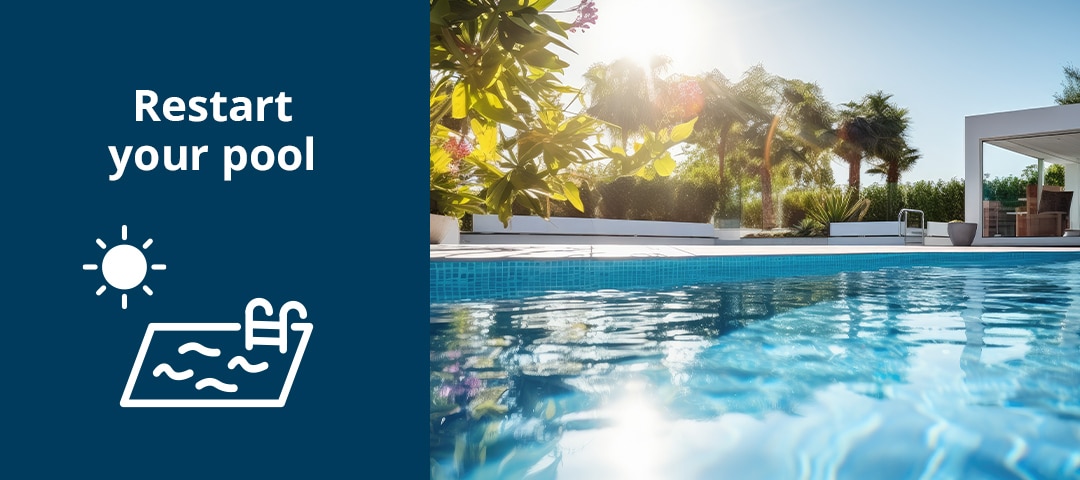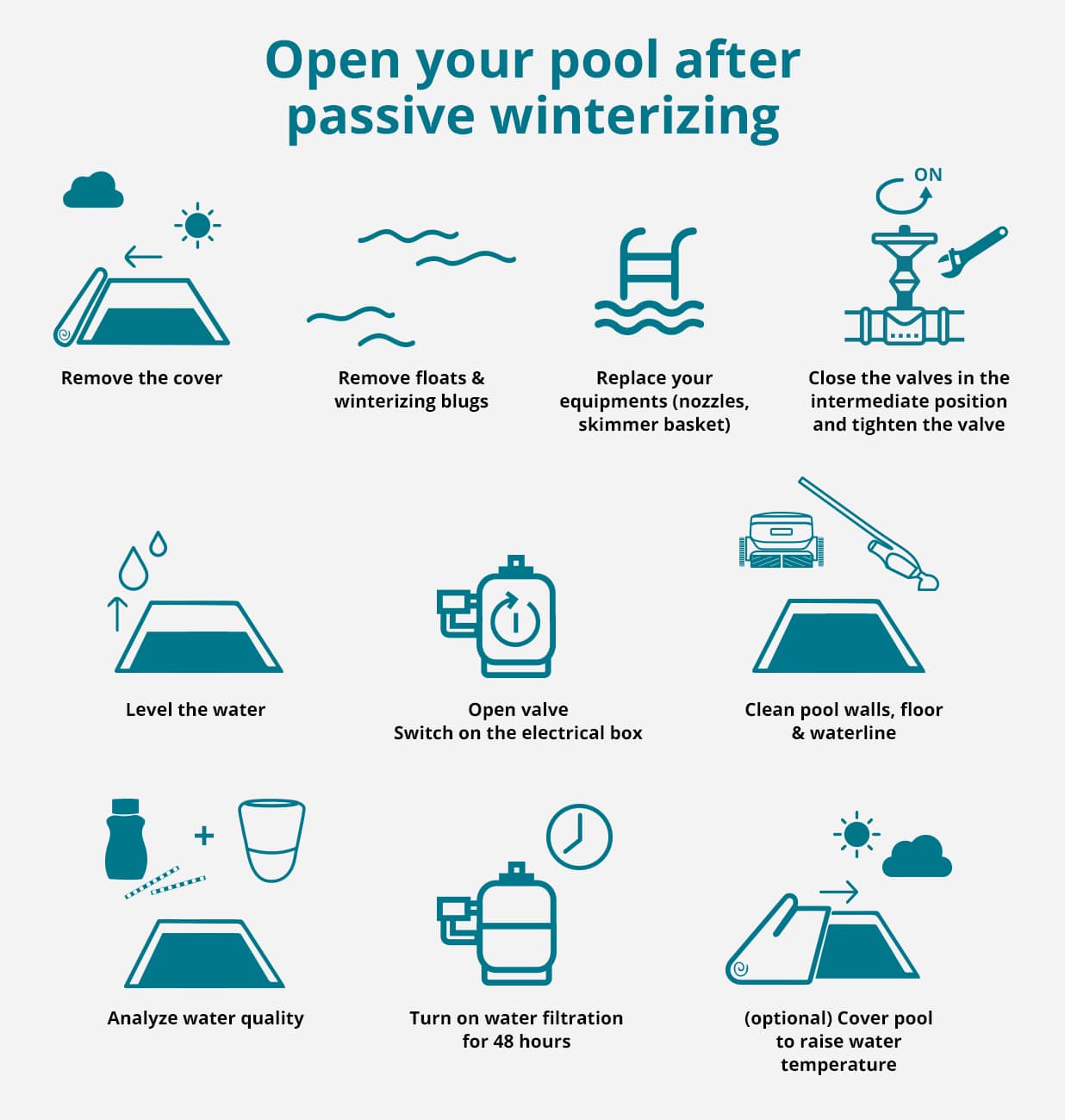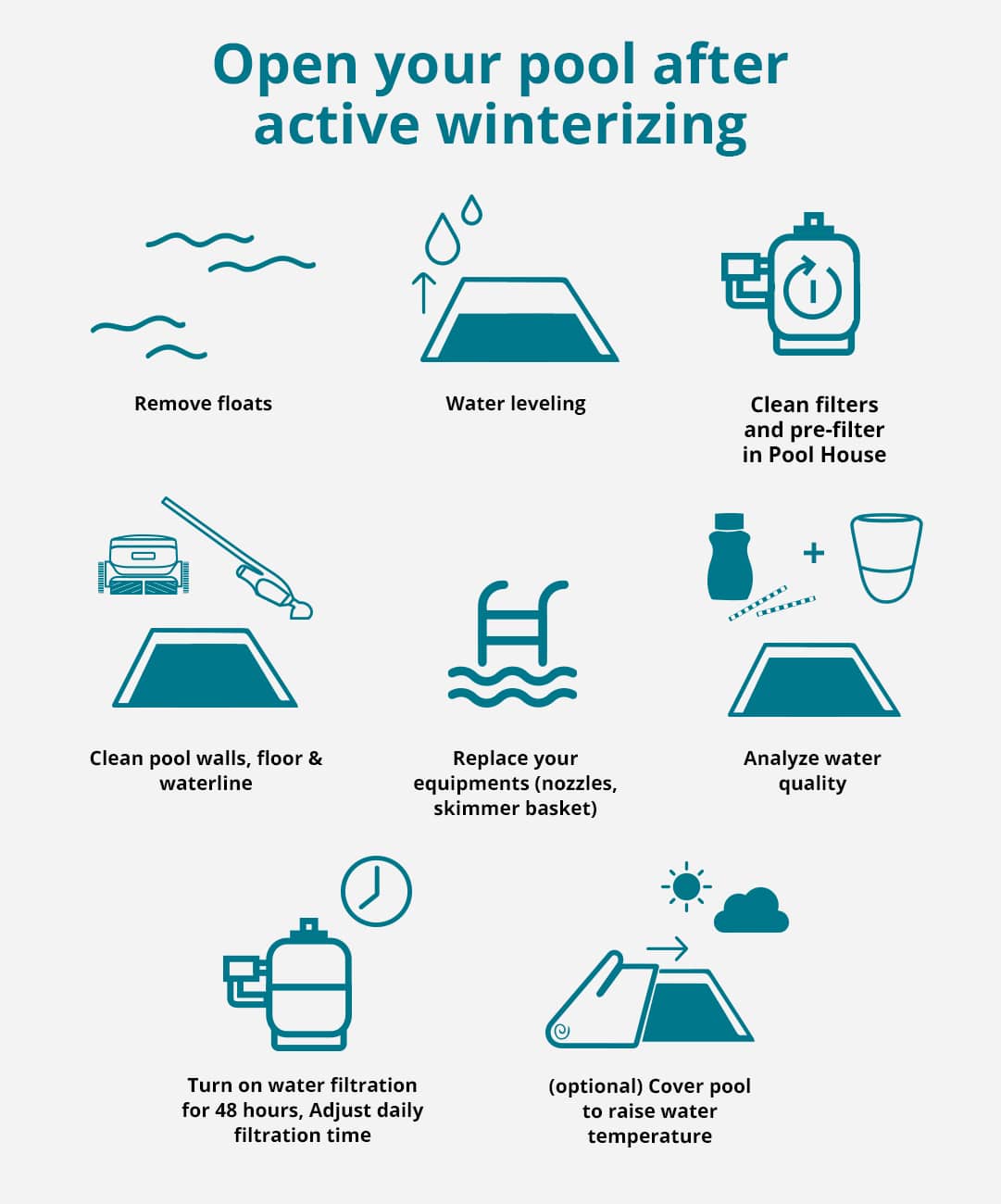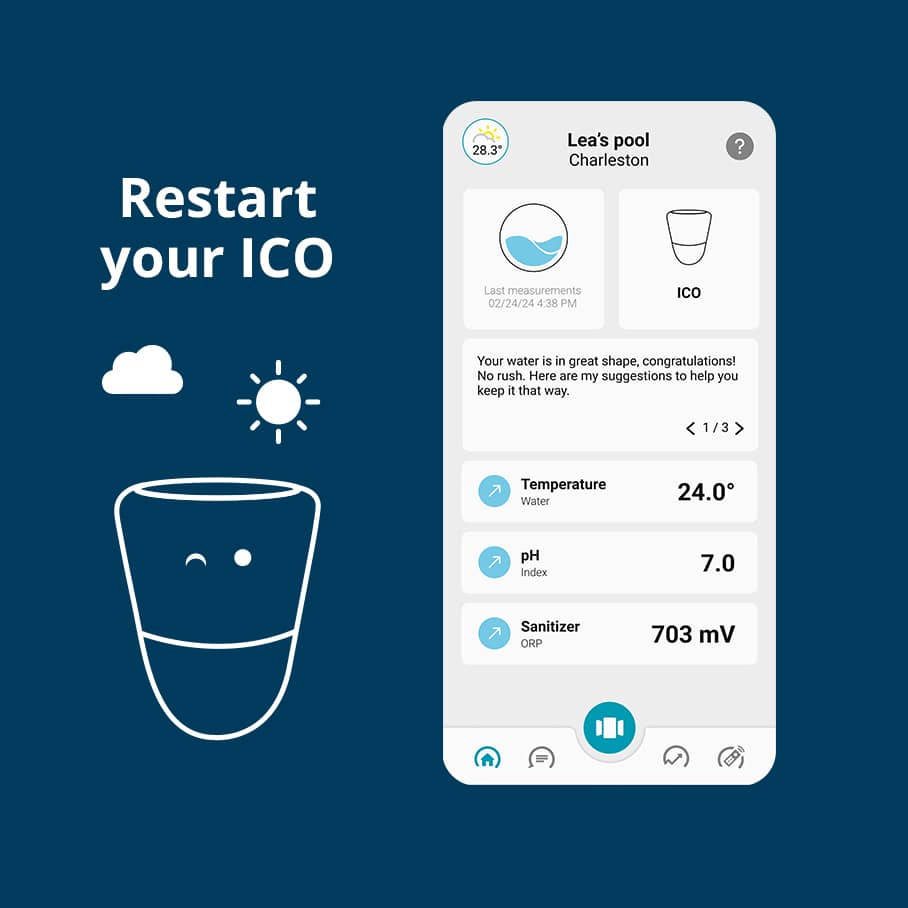When the fine weather arrives, it's time to put your pool back into operation. When the water temperature exceeds 12°C for chlorine-bromine pools and 15°C for salt-treated pools. What should you do after passive or active wintering? What treatments should be used? How should the filters be cleaned? These steps are very important to avoid the appearance of algae and micro-organisms from the start of the season.
Follow our step-by-step advice to get the season off to a great start and enjoy a beautiful pool all summer long!

To determine when to restart your pool, the water temperature :
Depending on your location, the start-up period is generally in early spring, between mid-March and mid-April.
It may be a tempting idea to put off starting up your pool in order to save on electricity or maintenance costs, but it's a bad idea! In fact, the rise in water temperature leads to the development of bacteria and, in particular, the appearance of green algae. You run the risk of having to treat these algae with costly products to restore clear, healthy water, in addition to the time spent scrubbing the walls. To avoid this stress at the start of the season, keep an eye on the water temperature and summerize your pool without delay.
On the other hand, restarting too early in the season can put your equipment at risk if the frost returns.
The steps involved in restarting your pool after active or passive wintering are different. It is therefore imperative to adapt the process.

Cover: clean and dry the cover before storing it in a dry place
Now that the risk of frost has passed, you can take out the gizmos, floats and wintering plugs, clean them and put them away until the end of the season.
Refit filtration accessories such as filter socks and nozzles, then screw adjustable jets into the outlets.
Open the valves in the intermediate position and retighten the unions on the valves, filter and pump.
In order for the pump to operate, the water level must be raised to about ¾ of the skimmers.
It's important to clean and check your filtration system so you can enjoy peace of mind all season long. To do this, close the drain plug on your filter. Then replace the drain plug on your filtration pump. Fill the pre-filter with water and tighten the lid. Thirdly, open the valves in the equipment room and set the valve to filtration. Finally, switch on the electrical box and restart your equipment.
To begin with, descale and desand the filter. To find out how to clean your filter, read this article. If you have a cartridge filter, put in new cartridges.
Maintenant c’est au tour du bassin. Avec vos équipements habituels (robot, balais, brosse, épuisette) nettoyez toutes les parois, la ligne d’eau et la surface de l’eau pour enlever tous les résidus. Si vous avez une piscine avec du carrelage, c’est le moment de nettoyer en profondeur vos carreaux avec un jet haute pression type kärcher. Il est également important de nettoyer également la zone autour de votre piscine (margelles, terrasse) qui peuvent être une source de pollution de l’eau, sans oublier le nettoyage du volet en insistant bien entre les lattes.
Une fois que la piscine est propre, remettez en place pour finir les accessoires d’été (échelle, plongeoir,…)
Après avoir remis à niveau l’eau de votre bassin puis filtrer l’eau pour l’oxygéner, il est temps d’analyser la qualité de l’eau. Il faut tester le pH, l’ORP (taux de désinfectant), le TAC (alcalinité de l’eau), le TH (dureté de l’eau). Voir le paragraphe ci-dessous sur l’analyse de l’eau de piscine en début de saison.
The first objective is to achieve a balanced pH (7.2 for chlorine treatment and 7.5 for bromine treatment), by adding pH+ or pH - in small quantities. Make sure you spread the product evenly throughout the pool to ensure it works more quickly.
Some professionals recommend systematic shock treatment, even if you've used a winterizing product. It's true that shock treatment is radical in killing bacteria, but it's a powerful chemical that comes at a cost. It's not an obligation, therefore, when passive wintering has been carried out according to the rules of the art, and it allows you to consume products more responsibly.
Run your filtration for about 48 hours to ensure that your water is healthy and crystal clear. Then, readjust the daily filtration time according to the temperature of your pool.
If the outside temperatures are still cool, don't hesitate to cover your pool: this step is not compulsory, but it also protects the water from external pollution such as pollen, insects...
If you have winterised ICO, see our support page How to get your ICO Pool back on track. Otherwise, don't hesitate to take a look at our ICO Pool connected water analyser
During your active wintering period, you should have continued to filter your pool water for a few hours a day and treated it regularly to maintain its quality. Now it's time to resume more active filtration after a good cleaning.

If you have used equipment such as a winter cover or antifreeze floats, clean and dry them before storing them for the season in a clean place.
If necessary, adjust the water level up to ¾ of the skimmers. To keep your water healthy, we recommend changing 1/3 of your pool water every year to eliminate micro-organisms and traces of chemicals. But if you've been cleaning your pool regularly throughout the winter, this isn't necessary.
In the Pool House, change filters (cartridge, sand, etc.) and pre-filter if necessary, to guarantee the quality of your filtration system for the summer.
Start by cleaning all the walls, the water line and the water surface to remove all residues. Don't forget to clean the area around your pool that could contaminate the water, as well as the roller shutter, insisting on cleaning between the slats.
Once the pool is clean, put back the accessories (ladders, diving board,...)
Now is the time to measure the quality of your pool water. Here are the parameters to analyse: pH, TAC, TH. See the paragraph below on water analysis.
Depending on the pH, add pH+ or pH- in small quantities. Also adjust the TAC.
Shock treatment of your pool after active wintering is only necessary in the event of green water or the presence of green algae. It rapidly destroys organisms, fungi and bacteria. If this is the case, make sure you distribute the product evenly throughout the pool, so that it acts quickly and effectively. If you have an automatic electrolysis treatment system, adjust the salt level before restarting the unit.
Run your filtration for about 48 hours to ensure that your water is healthy and crystal clear. Then, readjust the daily filtration time according to the temperature of your pool.
If the outside temperature is still cool, you can cover your pond with a bubble cover or your roller shutter. This also prevents the water from cooling down too much at night, allowing it to gradually rise in temperature. This allows the water to warm up slowly, while protecting water quality.
If you've winterized ICO, here's how to get your ICO Pool up and running again. Otherwise, don't hesitate to discover our ICO Pool connected water analyzer.
Si vous avez hiverné votre ICO Pool, il a aussi besoin d’être remis en route au printemps. Pour bien débuter la saison avec l’analyse de l’eau, vous trouverez dans notre page assistance comment remettre en route ICO les différentes étapes : mettre à jour l’application et le logiciel, charger, régénérer et calibrer les sondes pH et ORP.

| Cookie | Duration | Description |
|---|---|---|
| cookielawinfo-checkbox-analytics | 11 months | This cookie is set by GDPR Cookie Consent plugin. The cookie is used to store the user consent for the cookies in the category "Analytics". |
| cookielawinfo-checkbox-functional | 11 months | The cookie is set by GDPR cookie consent to record the user consent for the cookies in the category "Functional". |
| cookielawinfo-checkbox-necessary | 11 months | This cookie is set by GDPR Cookie Consent plugin. The cookies is used to store the user consent for the cookies in the category "Necessary". |
| cookielawinfo-checkbox-others | 11 months | This cookie is set by GDPR Cookie Consent plugin. The cookie is used to store the user consent for the cookies in the category "Other. |
| cookielawinfo-checkbox-performance | 11 months | This cookie is set by GDPR Cookie Consent plugin. The cookie is used to store the user consent for the cookies in the category "Performance". |
| viewed_cookie_policy | 11 months | The cookie is set by the GDPR Cookie Consent plugin and is used to store whether or not user has consented to the use of cookies. It does not store any personal data. |